
Sportfish Management & Protection 2025
Kejimkujik National Park and National Historic Site
An information package and Angler Diary is included with every fishing permit at Kejimkujik National Park and National Historic Site.
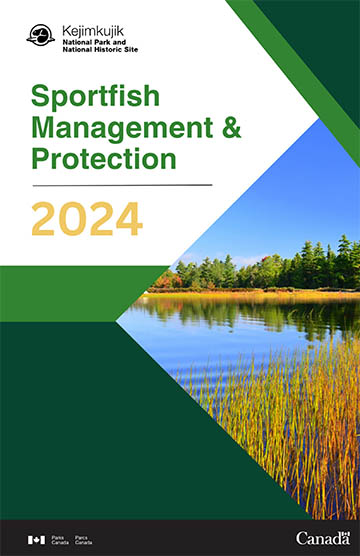
On this page
- Welcome to Kejimkujik
- Rules and regulations
- Angler Diary
- Native fish of Kejimkujik (catch and release)
- Invasive fish (mandatory retention)
- Fish consumption advisory
- Techniques for proper catch and release
- Fishing zones map
- More information
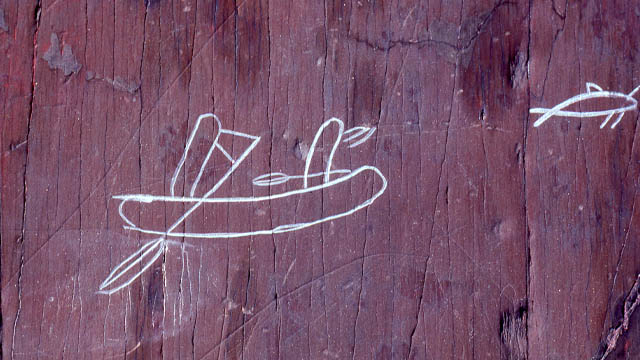
Welcome to Kejimkujik
Kejimkujik National Park and National Historic Site has a long and storied legacy of fishing in its dark waters. The waterways and lakes of Kejimkujik are an important cultural landscape to the Mi'kmaq who have used them for over 4000 years for traveling and fishing. Petroglyphs in the park depict people in canoes as well as fish. In the early 1900s, a resort was built in what is now Kejimkujik, and this region became widely known for its world-class guided fishing excursions. Fishing remains an important activity to many visitors to Kejimkujik.
Environmental impacts and the threat of invasive species have made conservation of native fish stocks a priority for Parks Canada. As of 2018, the invasive Chain pickerel has been expanding through the waterways of Kejimkujik. As part of efforts to preserve and protect the fish stocks as well as monitor the spread of this invasive fish, we have initiated an Angler Diary. Researchers at the park use the information collected from Angler Diaries to help assess the status of fish populations within the park, including the Brook trout.
We ask anglers to observe all fishing regulations, complete their Angler Diary, and submit them to the Visitor Center. Please release all native fish (see helpful tips) and humanely euthanize any invasive Chain pickerel that are caught. Please see instructions on what to do with Chain pickerel.
We hope you enjoy your time here and develop lasting memories as you return year after year! We thank you for your participation in our Angler Diaries program!
Happy fishing!
Rules and regulations
Complete National Park Fishing Regulations
For Kejimkujik-specific rules see the Warden Office board (17 Warden Housing Road).
Fishing seasons take place from April 1 to August 31, however, when the first day of an open season falls on a Sunday or Monday, the open season shall begin on the Saturday immediately preceding that Sunday or Monday. When the last day of an open season falls on a Friday or Saturday in any year, the open season shall end on the Sunday immediately following that Friday or Saturday.
A national park fishing license is required to fish in the park. The exception is anglers under 16 years of age who are accompanied by a license holder.
The entire park is 'catch and release' of all native fish species.
- All native fish must be returned to the water (this includes ALL species other than Chain pickerel and Smallmouth bass).
- No person may possess Brook trout or any other native fish species within the park boundary.
It is mandatory to retain Chain pickerel and Small mouth bass caught inside the park. If you catch one of these invasive fish, keep it, kill it, and tum it in at the Warden's Office. What to do with a Chain pickerel
Zones: The map shows the "Fly-Fishing Only" and "No Fishing Zones". The following regulations apply within the fly-fishing zones:
- Fly-fishing only
- No fishing of any kind is allowed within: Rogers Brook, Grafton Brook, Pebbleoggitch Lake, Beaverskin Lake, Cobrielle Lake and Mountain Lake.
It is required to fill out your Angler Diary and submit it.
It is illegal to place live fish eggs or live fish into park waters.
It is illegal to have a line with more than one artificial fly or other type of bait (or any combination) attached.
Any lure or fly cannot be capable of catching more than one fish at a time.
All tackle may only include single barbless hooks. True barbless hooks or a pinched down barb are acceptable. Treble, gang, or barbed hooks of any kind are not permitted.
No person shall use natural bait of any kind (including minnows and earthworms) or have it in their possession.
Possession or use of chemical attractants is not permitted.
Possession or use of lead jigs, sinkers, or weights is not permitted.
Electronic fish finders are prohibited in all national parks.
Fishing is prohibited during the period from one hour after sunset to one hour before sunrise.
Outboard motors are not allowed on Kejimkujik waterways other than Kejimkujik Lake and downstream of Kejimkujik Lake to the park boundary.
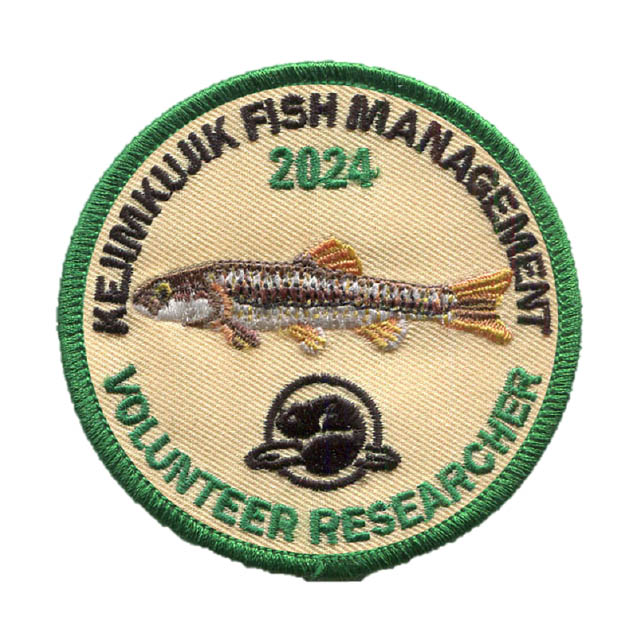
Angler Diary
Each license with a completed and returned Angler Diary will receive a commemorative patch!
An Angler Diary is included with every fishing permit. Additional "Fishing Effort Cards" are available at the Visitor Centre.
The information collected provides Kejimkujik researchers and managers with the information needed to make informed decisions regarding the health, protection, and future of our Brook trout population and the entire aquatic ecosystem within Kejimkujik.
"Fishing Effort Card" example
For example: This angler fished on April 1 at Frozen Ocean Lake with spinning gear for 5.5 hours, targeting White perch. The angler caught 6 White perch and 8 Yellow perch.
Fishing Effort Card
License number: 1234567890
| Date (dd/mm) | Water fished | Fly (Y/N) | Hours fished | Target species | Brook trout | White perch | Yellow perch | Chain pickerel | Brown trout | Bullhead catfish | White sucker | Creek chub | Other |
|---|---|---|---|---|---|---|---|---|---|---|---|---|---|
| 01/04 | Frozen Ocean | N | 5.5 | White perch | 6 | 8 | |||||||
Directions
- Record information for YOUR fishing only.
- Separate entries for each waterbody fished.
- Please indicate (Y or N) if using fly fishing gear.
- Record target species. If you are targeting anything write "ANY".
- Record total number caught of each species.
- Please return this diary even if you do not catch anything.
How to submit your Angler Diary
Drop off
Your Angler Diary may be dropped off at the Visitor Centre, Science Centre, or Warden’s Office.
In case the form was forgotten in your tackle box you can mail it to us at:
Kejimkujik Angler Diary
3005 Main Parkway
Maitland Bridge, NS, B0T 1B0
Or contact the Freshwater Coordinator, Brandon Nilsen at Brandon.Nilsen@pc.gc.ca
Angler Diaries Annual Report
Everyone who submits their Angler Diary can also get a copy of the 2024 Angler Diaries Annual Report! This report outlines the results of the angling season for the year at Kejimkujik.
If you would like a copy of the Angler Diaries Annual Report, please provide either your email address or mailing information (name, address, city, and postal code).
We always appreciate your feedback or any comments you may have.
Native fish of Kejimkujik (catch and release)
Brook trout (Salvelinus fontinalis)
The Brook trout have small yellow spots over an olive-green back. Along its sides, the brook trout’s color transitions from olive to orange or red, with scattered red spots bordered by pale blue. Its lower fins are orange/red, each with a white streak and a black streak, and its underside is a milky white.
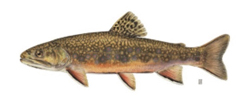
Yellow perch (Perca flavescens)
The Yellow perch is oval shaped with a deep, laterally compressed, oblong body. Two Dorsal fins and a bright yellow and green body with thick darker lateral markings.
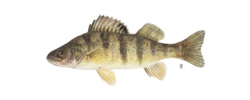
American eel (Anguilla rostrata)
The American Eel is long and skinny, with a fin extending along its back and another long fin from stomach to tail with a green/yellow back transitioning to a white underbelly.

White perch (Morone americana)
The White Perch is a silvery greenish-gray fish with a dark, highly domed back, spines are present on a deeply notched dorsal fin.

Golden shiner (Notemigonus crysoleucas)
The Golden shiner is a small schooling fish with a thin and deep body, and a small triangular head with upturned mouth and a prominent golden coloration on the side with a silver body.

Creek chub (Semotilus atromaculatus)
The creek chub has a dark brown body with a black lateral line from tip to tail with a prominent darker horizontal band across a silver-brown body.
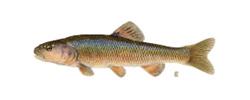
Banded killifish (Fundulus diaphanus)
The Banded Killifish has olive-colored sides with numerous silver-blue vertical bands and a contrasting dark coloration across the dorsal region.
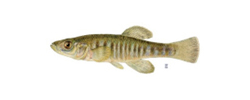
White sucker (Catostomus commersonii)
The white sucker has a downturned mouth with thick lips, a single non-spined dorsal fin, and a tail fin with a strong indent. They are a silver coloration with transitioning to a white underbelly.

Ninespine stickleback (Pungitius pungitius)
The Ninespine stickleback has bony scutes instead of scales on the sides and usually nine small isolated dorsal fin spines.

Brown bullhead (Ameiurus nebulosus)
The Brown Bullheads has four pairs of barbels, no scales, stout spines at the origins of the dorsal and pectoral fins. They are a brown-grey colour with a white underbelly.

Lake whitefish (Coregonus clupeaformis)
The Lake whitefish is olive-green to blue on the back with silvery sides. The fish has a small head relative to its body and presence of two small flaps in each nostril.
Historically stocked
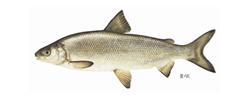
Brown trout (Salmo trutta)
The Brown trout is golden brown with large black spots on the back and red spots (some with pale halos) on the sides.
Historically stocked

Monitoring for Smallmouth Bass
At present, there have been no confirmed sightings of Smallmouth bass in the park, but staff are currently monitoring for their presence. We appreciate the dedicated visitors who take part in our Angler Diary program.
If you suspect you caught a Smallmouth bass, please take pictures, record the location where it was caught and email us at brittni.scott@pc.gc.ca.
In Kejimkujik, it is mandatory to retain invasive fish species. When possible, invasive fish can be brought to one of our drop-off sites.
Invasive fish (mandatory retention)

Chain pickerel (Esox niger)
The chain pickerel are a long slim bodied fish with dark chain-like patterns on its green-yellow sides and a dark marking extends downward from the eyes. An elongated mouth with many small sharp teeth.
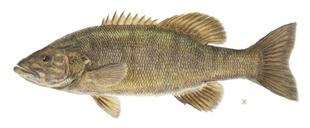
The Smallmouth Bass is a dark to olive green coloured fish with darkened lateral bands. Dark bars radiate back from a red coloured eye and one bar radiates from the eye to the snout. The jaw does not extend past the eye. The two dorsal fins are joined together.
Chain pickerel in Kejimkujik
Smallmouth bass threaten the park boundary and Chain pickerel have now invaded Kejimkujik. Work is ongoing to mitigate impacts to watersheds in the park. In addition to our management efforts, we updated Kejimkujik fishing rules beginning in 2019 to help protect native fish, including the retention of invasive species.
Acoustic tagged Chain pickerel in George Lake
In order to better understand Chain pickerel habitat use and movement patterns 18 acoustic receivers were deployed in George Lake and 60 Chain pickerel were caught, tagged, and released back to the water. This may seem counterproductive, but these 60 fish provide valuable information that we will use to better mitigate and manage their impacts. If caught, please return these fish where they were captured so they can continue to provide data for these projects.
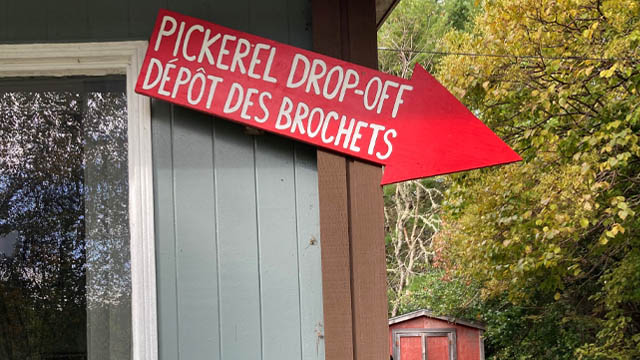
What to do with a Chain pickerel
Chain pickerel are under mandatory retention within the park.
Please humanely euthanize your Chain pickerel as soon as you catch it. This entails a swift singular blow to the top of the head just behind the eyes and a subsequent cut to the gills.
We ask that you bring your Chain pickerel to one of our ‘Pickerel Drop Off ’ sites, either at 21 Warden Housing Road or the Campground Kiosk. You can find a freezer at both of these locations with instructions on how to properly dispose of your pickerel.
In coordination with Acadia University, pickerel that are dropped off will be studied, including gut contents, size, and stage of sexual maturity. This is valuable information tor helping understand the impacts of this invasive species to the aquatic ecosystems in the park.
If you are unable to submit a Chain pickerel, please euthanize it and return it into the waterway or into the woods away from campsites, trails, or portage routes.
Fish consumption advisory
Mercury has been detected in certain species of freshwater fish, prompting advisories to restrict consumption. Predatory fish such as Chain pickerel tend to accumulate higher levels of mercury.
Techniques for proper catch and release
By following these guidelines, you can greatly increase your fish's chance of survival after release!
5 second rule
Ensure that you strictly limit the time your fish spends out of water. Time out of water is extremely stressful on fish and keeping that time to a minimum is the primary way you can increase their survival. This doesn't mean you can't take a picture, just prepare for your photo with your fish safely under the surface. When you lift the fish out of water, do it for 5 seconds or less.
Use barbless hooks
Using barbless hooks is MANDATORY in Kejimkujik. Barbless hooks can be purchased, or you can use pliers to press down the barb on your hook. Barbed hooks can cause serious damage to the fish and are harder to remove increasing fish handling time.
Leave deep set hooks
If your fish takes a hook deep and it can't easily be removed, cut the leader/tippet as close as you safely can and leave the hook in. The fish will eventually shed the hook on its own, the hook will corrode, or new tissue will surround the hook. Attempting to dig out a deep hook often results in a mortally wounded fish. One study has shown that more than 67% of fish survive with the hook left in place, whereas only 11% of fish survived after having a deep set hook removed.
Don't exhaust the fish
Fight your fish in with authority. Playing a fish for several minutes on a leader/tippet that's too light for the fight is likely to exhaust a fish past a point from which it can recover.
Wet your hands
When it comes time to handle the fish, always get your hands wet. Dry hands are much more likely to remove a fish's layer of mucus or slime which protects the fish from infections caused by fungus, bacteria, and parasites.
Use a net
Landing nets provide one of the few reliable ways to release a fish without extensively handling and also allow you to land a fish more quickly. Try to use a dip net whenever possible, particularly a good quality catch and release net made of rubber mesh are less damaging to the fish.
Watch its head
The fish at the end of your line relies on its eyes and gills to survive. A fish's head is fragile and needs to be protected. Head injuries are one of the leading cause of fish mortality after release.
Avoid the shore
Never land your catch by dragging it onto the rocks, beach or even grass along the shoreline. These environments are no place for a fish. Putting a fish on the shore virtually guarantees you're harming the fish in some way (e.g., disturbing the fish's protective mucus, keeping the fish out of the water too long, increasing risk of head and eye injuries). Keeping your catch wet increases the chances of survival.
Revive it properly
Face your fish upstream or into the current, and let it breathe normally. Do not try to drag your catch back and forth in the water in order to help it revive. This sort of action actually impedes the fish's ability to move water through the mouth and across the gills to obtain oxygen. Also, take care not to revive your fish in sediment-filled water. If you've disturbed the bottom, move into clean, clear water with a moderate flow and revive the fish there. Be patient and let the fishes behavior tell you when it is ready to swim away.
Watch the temp
Many fish, Brook trout in particular, prefer cool to cold water and are in increased danger of stress and exhaustion as water temperatures increase and oxygen levels decrease. Pay attention as stream and air temperatures increase later in the season. Know your target species and how hot is too hot for the fish you're pursuing. Park biologists stop working on Brook trout when water temperatures reach 20°C.
Fishing zones map
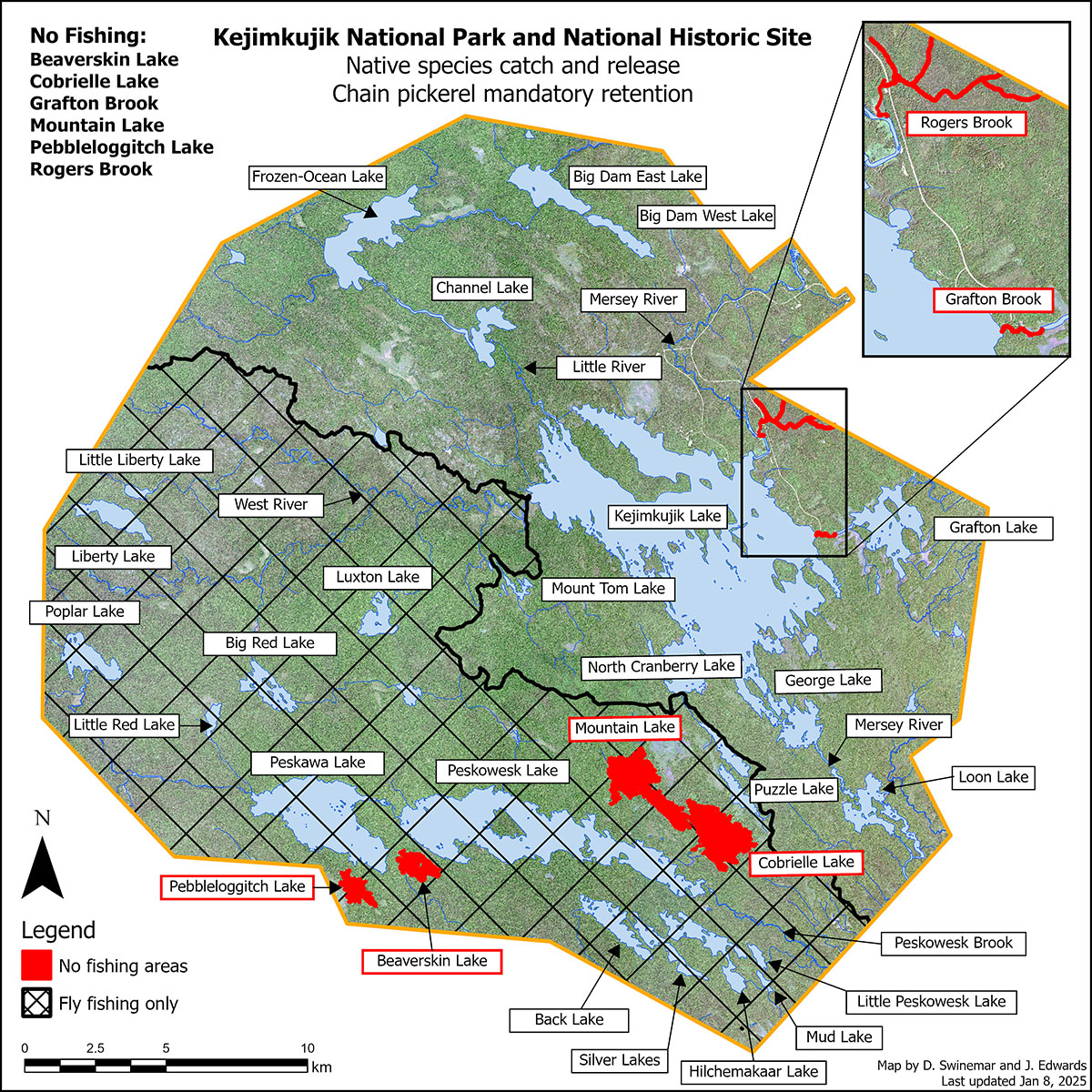
Text version
Map by D. Swinemar and J. Edwards. Last updated January 8, 2025.
Native species: catch and release.
Chain pickerel: mandatory retention.
No fishing
No fishing of any kind is allowed within:
- Rogers Brook
- Grafton Brook
- Pebbleoggitch Lake
- Beaverskin Lake
- Cobrielle Lake
- Mountain Lake
"Catch and release no-kill" fishing zone
The "Catch and release no-kill" fishing zone includes the following brooks and lakes in the Northern and Eastern areas of Kejimkujik.
- Big Dam Lake
- Channel Lake
- Frozen Ocean Lake
- George Lake
- Grafton Lake
- Kejimkujik Lake
- Little River
- Loon Lake
- Mersey River
- Mount Tom Lake
"Fly fishing only" zone
The "fly fishing only zone" includes the following brooks, lakes, and rivers in the Western and Southern areas of Kejimkujik.
- Back Lake
- Big Red Lake
- Hilchemakaar Lake
- Little Liberty Lake
- Little Red Lake
- Little Peskowesk Lake
- Liberty Lake
- Luxton Lake
- Mud Lake
- North Cranberry
- Paskawa Lake
- Peskowesk Brook
- Peskowesk Lake
- Poplar Lake
- Puzzle
- Silver Lakes
- West River
- Date modified :